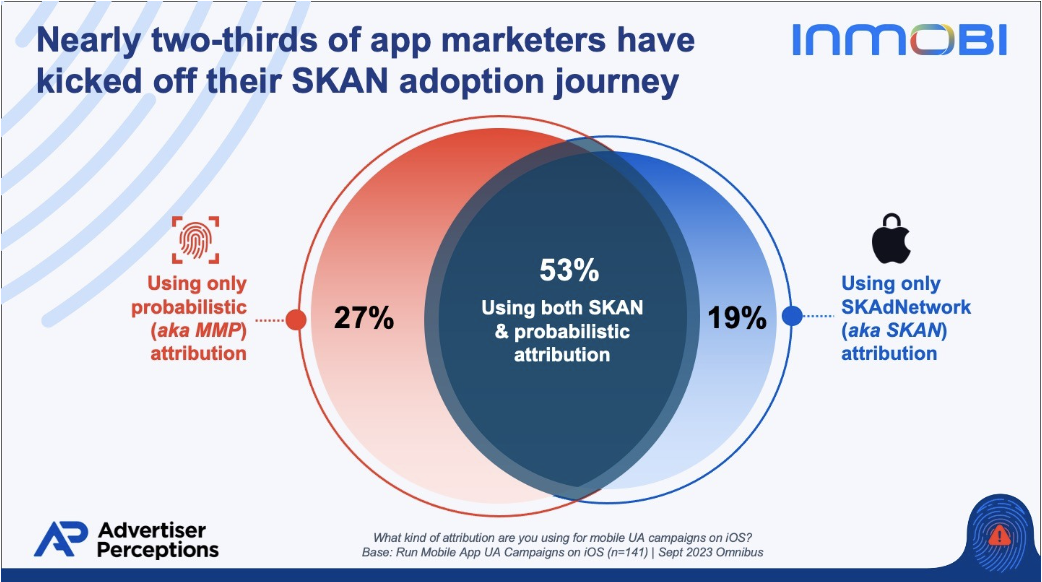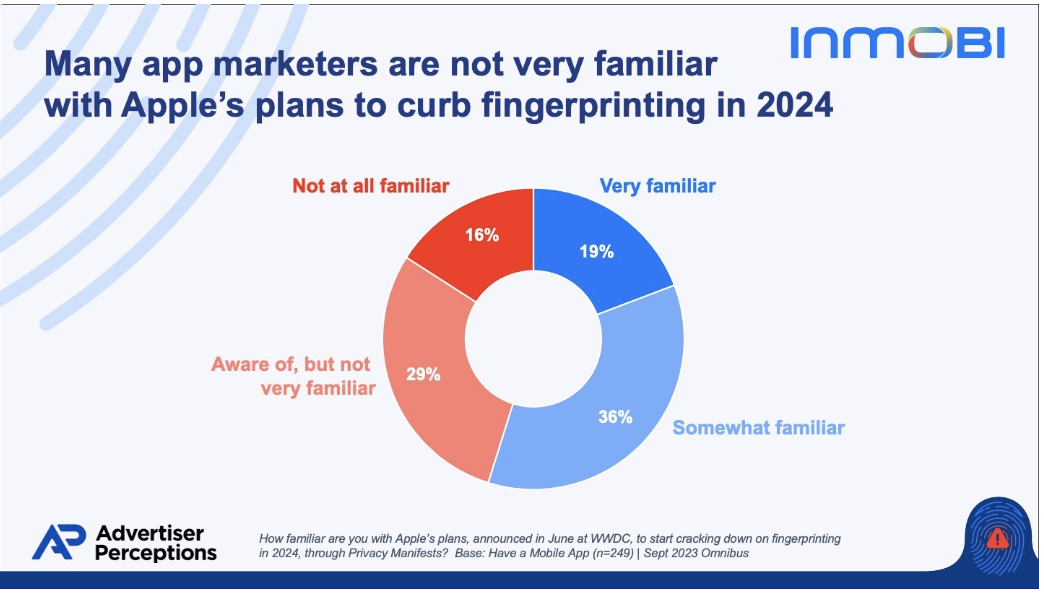- For Advertisers
-
For Publishers
- For Retail Media
- For Telcos
- Our Consumers
- Resources
- GET STARTED
-
Login Login

New research by Advertiser Perceptions and InMobi reveals notable progress towards SKAN adoption with some ground left to cover before all app marketers are fully ready to enter the privacy-first era of iOS campaign attribution.
Apple’s App Tracking Transparency (ATT) upended campaign attribution on iOS two years ago, and app growth marketers have been operating in survival mode ever since. While some have taken the time to transition to SKAN, others are still clinging to attribution methods that rely on fingerprinting, also known as “probabilistic attribution” or “MMP attribution,” as a lifeline.
However, the prevailing theory has been that this approach is only a temporary workaround for Apple’s sanctioned privacy-safe attribution framework, SKAdNetwork (SKAN). This theory is grounded in the fact that Apple has had a rule prohibiting fingerprinting in its iOS developer policies since ATT rolled out, and it’s only a matter of time before Apple starts to enforce it.
Because Apple has levied no consequences on apps using fingerprinting, the full force of ATT has yet to make impact. But with a new set of features in iOS 17 aimed at closing this loophole starting in spring ’24, we are now on a collision course, which we’ve covered in more detail here.
To understand if app marketers and their agency partners are taking heed of this wake-up call, InMobi worked with Advertiser Perceptions to take a temperature check in September 2023. The results of this survey reveal there is still work to be done before apps can successfully change course and be prepared for the privacy-first era ahead.
Current attribution methods being used
While still common for apps to maintain a level of reliance on fingerprinting-based attribution, nearly two-thirds have begun their SKAN attribution adoption journey.
If fingerprinting-based attribution methods still play a part in your app growth strategy, you are certainly not alone. However, if you fall in the 27% of app marketers who have not begun to embrace SKAN and rely only on probabilistic workarounds for measuring campaign performance on iOS, you’re lagging behind your peers.

Why are marketers not adopting SKAN?
The top reason why marketers are not adopting SKAN is because they are hitting the easy button with probabilistic attribution. SKAN’s complexity as well as the perception of reduced performance and cost-effectiveness are other key reasons why some app marketers have been avoiding SKAN at this point.

Marketers’ understanding of fingerprinting
There also seem to be gaps in understanding exactly what fingerprinting is and whether it is being used for campaign attribution. Nearly half of app marketers are blissfully unaware that probabilistic attribution may be considered fingerprinting, and another 17% aren’t even clear what fingerprinting is. A likely reason for this is because fingerprinting is often referred to as “probabilistic attribution” or “MMP attribution,” and measurement partners typically would not expressly call out that their models are employing fingerprinting.

Many are still not aware of Apple’s plans to end fingerprinting, let alone clear on what to do to prepare
Just over half of app marketers and their agencies reported that they are at least somewhat familiar with Apple’s plans to put an end to fingerprinting on iOS next spring. But on the flip side, almost half of those surveyed admit they are not very familiar with Apple’s plans to combat fingerprinting, and half of that group confessed they are entirely in the dark.

As far as what to do with this information, just over a quarter of survey respondents recognize the need to accelerate SKAN adoption plans, while the rest are in a “wait and see” reactive mode with no immediate plans to change course. It’s hard to blame those who have chosen to let the dust settle before upending strategies that are performing acceptably. Seeing the can getting kicked down the road by Google for three years on third-party cookie deprecation has created an “I’ll believe it when I see it” mindset amongst marketers. Apple has reinforced their policy against fingerprinting multiple times since ATT was released in 2021, but they have not yet taken any meaningful action to enforce this rule, at least until now.

Apple not only made their disdain for fingerprinting abundantly clear (again) during their Worldwide Developer Conference in June, they also announced details of how they would enforce it this time. A new feature called Privacy Manifests takes square aim at holding app developers and their third-party SDK partners accountable for disclosing their data collection and usage practices, and it zeroes in on a set of Required Reason APIs that Apple deems particularly high risk for abuse in fingerprinting. The Privacy Manifests feature was included in the recently released iOS 17 and is set to take full effect in the spring. To help app marketers gain a better grasp of what fingerprinting is, why it’s at risk of disappearing next year, and what they should do about it, InMobi has put together a handy guide: RIP Fingerprinting in 2024? The Need-to-Know and How App Marketers Should Prepare.
If you’re part of the 53% of app marketers using probabilistic attribution alongside SKAN, you’re on the right track and should look to accelerate SKAN adoption even further as spring 2024 approaches. For the 27% of apps who haven’t kicked off their SKAN adoption journey yet, it would be wise to set these plans in motion with urgency or risk winding up lost in the dark on a dead-end road with no probabilistic signals to help point you in the right direction.
I’ll be the first to admit that SKAN is indeed complicated and early versions had significant limitations, but the good news is that Apple is committed to continually improving it. SKAN 4 has brought significant improvements over SKAN 3, and SKAN 5 is on the way. SKAN’s deterministic accuracy is unmatched and any perceived drawbacks can be overcome with the right shift in mindset complemented by effective predictive modeling that offsets privacy-minded signal loss. Leading apps in every category are finding ways to successfully navigate it alongside partners with the right expertise and solutions.
If you’re ready to start accelerating your SKAN adoption journey before fingerprinting fades away, InMobi’s Ultimate Guide to SKAN is a comprehensive resource designed to help you along the way, and if you could use some personalized advice from our team of SKAN experts as you map out the right strategy to ensure your app’s performance is ready to thrive in the privacy-first world, just say the word.
You can dive into our full research with Advertiser Perceptions on the 2023 state of app performance campaign attribution in the privacy-first era here:
Register to our blog updates newsletter to receive the latest content in your inbox.